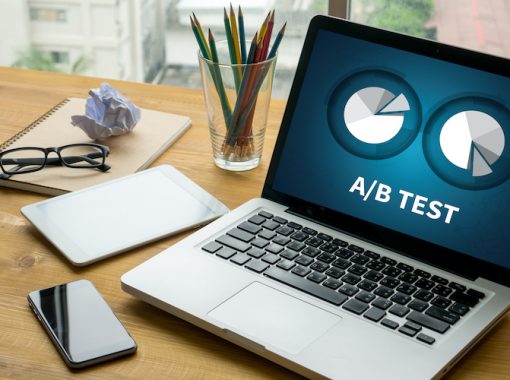
An organic SEO strategy is a long-term play.
Unfortunately, results don’t happen overnight! It takes a significant amount of time and effort to plan and execute a solid search engine optimization (SEO) strategy that produces strong Google rankings and excellent website traffic.
But what happens if, after months and months of keyword research, creating optimized content, and garnering quality backlinks, your website still doesn’t rank well on Google?
While several factors can play into the cause, one way to dig deeper and find the answer is through SEO A/B Split Testing.
What is A/B Testing?
Also known as split testing, A/B testing is the process of experimenting with different marketing variables to determine which generates the most or best results.
Advertisers, for instance, use A/B testing in focus groups to identify which ad campaign has a better chance of producing results. Advertisers divide the group into two segments. Group A sees one version of the ad, while Group B sees another.
The differences between each ad campaign are not massive, however. Changes can include copy updates, different imagery, or where the logo is placed.
For SEO purposes, we use A/B testing to:
Determine User Preferences
What copy/imagery/forms do website visitors respond to? Which meta description format drives the most clicks? Marketers need to ask a multitude of questions to fully understand their target audience.
By experimenting with SEO variables, marketers can pinpoint what copy, formats, and media their users prefer to interact with.
Identify What Isn’t Working
Can’t figure out why your website traffic is so low or declining? Split test a few variables to determine the problem.
In the process, you’ll discover what’s holding you back from the results you’ve been looking for!
Improve Results Without a Significant Investment
When website traffic results are dismal, some business owners make the mistake of thinking that there’s something wrong with their website design and function. This assumption launches them into a whole, unnecessary website redesign project.
Website redesigns can cost thousands of dollars and, not to mention, precious company time and resources. Chances are, after conducting a few SEO A/B split tests, the problem will be an easy fix — and one that doesn’t cost most of your marketing budget to fix.
5 Aspects of an SEO Campaign You Can A/B Split Test
Remember, the key to A/B testing — especially when it comes to search engine optimization — is to test one variable at a time. Don’t overwhelm yourself by making sweeping changes and attempting to translate the results?
Instead, start small and tinker with A/B testing these five aspects of an SEO campaign.
1. Meta Titles & Descriptions
If you’re having trouble driving website traffic with your organic SEO strategy, chances are the meta titles and descriptions for your pages aren’t interesting enough.
(Or you’re ranking terribly low — or not at all — for your intended keyword. But that’s an entirely different SEO problem!)
To start an A/B split test of your meta titles and descriptions, you’ll need two landing pages to work with. It is recommended that the landing pages each be written about the same topic, but do not include the same copy or media to avoid repetitive content on your website.
Or, you can streamline the process by updating the formatting of the meta titles and descriptions of existing pages. Use two formats (such as including a CTA in the title or beginning of a description) and apply one to each page’s SEO data. Track the results of each grouping to see which generates the best results!
2. Landing Page Copy and Headlines
Sometimes, a search engine optimization strategy can drive a great amount of traffic, but the conversion rate is dismal.
This indicates that the problem with the SEO strategy lies in the landing page copy and headlines. It’s doing a great job of ranking high on Google, but a poor job of convincing visitors to take the next step, whatever that may be.
To split test landing page copy and headlines, you’ll need to create two copies of the landing page: the original (also referred to as the control and the test.)
However, if you’re well-versed in SEO tactics, you know that this approach may present a problem: Duplicate content.
Google hates repetitive content on a website. Copying and pasting the same content across a website is seen as a non-authoritative and weak tactic and the search ranking algorithms fight against this.
When A/B testing landing pages, you’re likely only changing certain sections or headlines within the copy. This leaves a great deal of repetitive content on both pages.
To ensure that your SEO A/B testing landing pages perform correctly and do not negatively impact your ranking efforts, use these tips:
- Always include a “No index” tag in the header code of the duplicate landing page. This instructs Google’s algorithm and crawlers not to include the second page in the algorithm’s database.
- Try to change up the copy enough to run a successful, proper experiment but also not trigger a duplicate content flag.
- Do not include the second landing page in your robots.txt file!
- Make sure you use a canonical tag or reference to the control or original landing page on the duplicate page.
- Never link to the duplicate page from other areas of your website. This can ruin the entire A/B split test!
3. Landing Page Layout and Design
Similar to headlines and copy, the overall layout and design of a landing page can have drastic effects on the success or failure of an SEO campaign.
Following the same principles and tactics as landing page copy, make small adjustments to the duplicate page rather than large, sweeping changes.
For instance, if your original landing page included a banner image at the top, consider replacing it with a “Welcome” or product demonstration video.
Or, perhaps the original landing page placed the call-to-action on the bottom of the page. Move it higher on the duplicate page and see if it increases the overall conversion rate!
4. Form Fields
Have you ever felt like a contact form was asking too much from you? Chances are, your website visitors have felt the same way.
Launch an SEO A/B test to determine whether or not your form fields are the problem.
Sometimes all you need from a lead are the basics like name, phone number, and email address. Other times, website visitors are willing to give you all the information in the world. But you’ll never know unless you try a split test to find out!
5. Call-to-Action
One of the most common SEO A/B split test variables is the call-to-action (CTA).
The call-to-action is the most powerful part of an SEO strategy. If the CTA doesn’t resonate with the audience or convince them to take the next step, what does it matter if you rank #1 on Google for the related keyword?
Fortunately, CTAs can be found throughout an SEO strategy. The meta title and description in Google rankings are prime real estate for calls-to-action. You have to convince users to click on your link, after all.
When formulating an SEO A/B split test, consider experimenting with the CTA variables in the:
- Meta titles
- Meta description
- Landing page copy and headlines
- Form buttons
- Imagery and videos
3 Key Tools to Use in an SEO A/B Split Test
In addition to tracking your organic website traffic metrics and rankings, there are three pertinent tools you can use to monitor your search engine optimization split test.
1. Google Optimize
Google Optimize works in tandem with Google Analytics to run A/B tests on your website. The tool is free to use and is perfect for running tests on minor websites or landing page changes like button copy or headlines.
2. Call-Tracking Phone Numbers
As much as search engine optimization is a digital marketing tactic, it still results in offline leads and consumer activity. If your SEO A/B split test isn’t taking offline leads and calls derived from the experiment into consideration, the results are flawed.
Call-tracking phone numbers are used across online marketing campaigns to effectively track and monitor offline leads. These phone numbers are used on social media profiles, display ads, email signatures, and more.
For instance, if you put your toll-free phone number in the meta description or title of your landing page, you know that all phone calls to that number were generated as the result of the A/B split test.
Factor these offline results in with the online results for a comprehensive look at which A/B test variable performed better.
3. Google Ads
When you need answers as soon as possible and have the budget to back it up, you can always run SEO A/B tests on Google Ads. Instead of waiting weeks or months to see organic results, you can estimate the potential results of your experiments by running them as Google Ads.
Be sure to monitor spending and the campaign duration to ensure that you don’t inadvertently spend your whole budget on a single test!
What Will Your First A/B Test Be?
Now that you’re ready to take on your first SEO A/B split test, have you decided what variables you’ll experiment with?
Remember to claim your call-tracking numbers for the best success!












